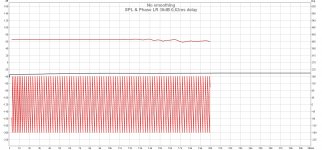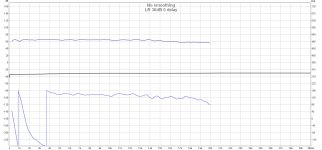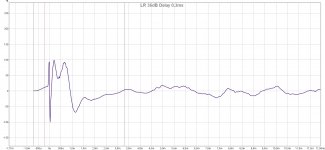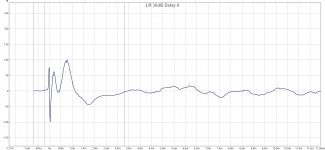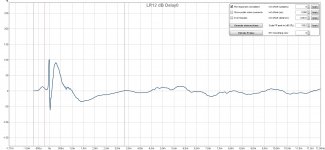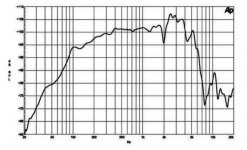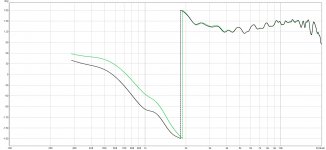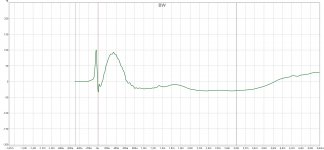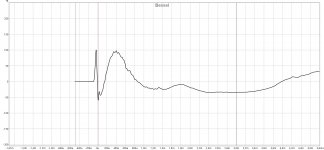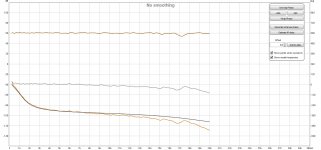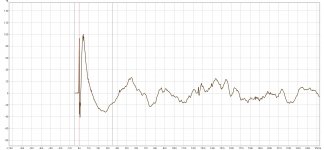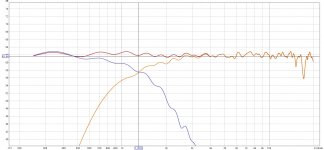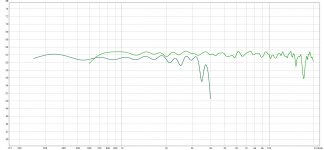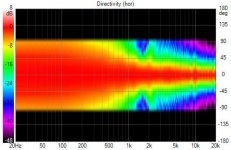Hi,
I recently finished my very first project that I want to share with you. Maybe you find some things I can improve. Parts I used:
-Faital Pro HF10AK in 12“ tractrix
-B&C 12PE32 in ~20L cb
-4x Beyma 12BR70 as subwoofers in ~70L (2x) and 80L (2x) cb
-DSP with 8 channels
Unfortunately I don’t have proper pics on my computer. But maybe you get the idea from my profile picture. Every driver has its own box. The speakers are placed in the corners of the room. You can find a sketch down below.
This is how the final measurements looks like:
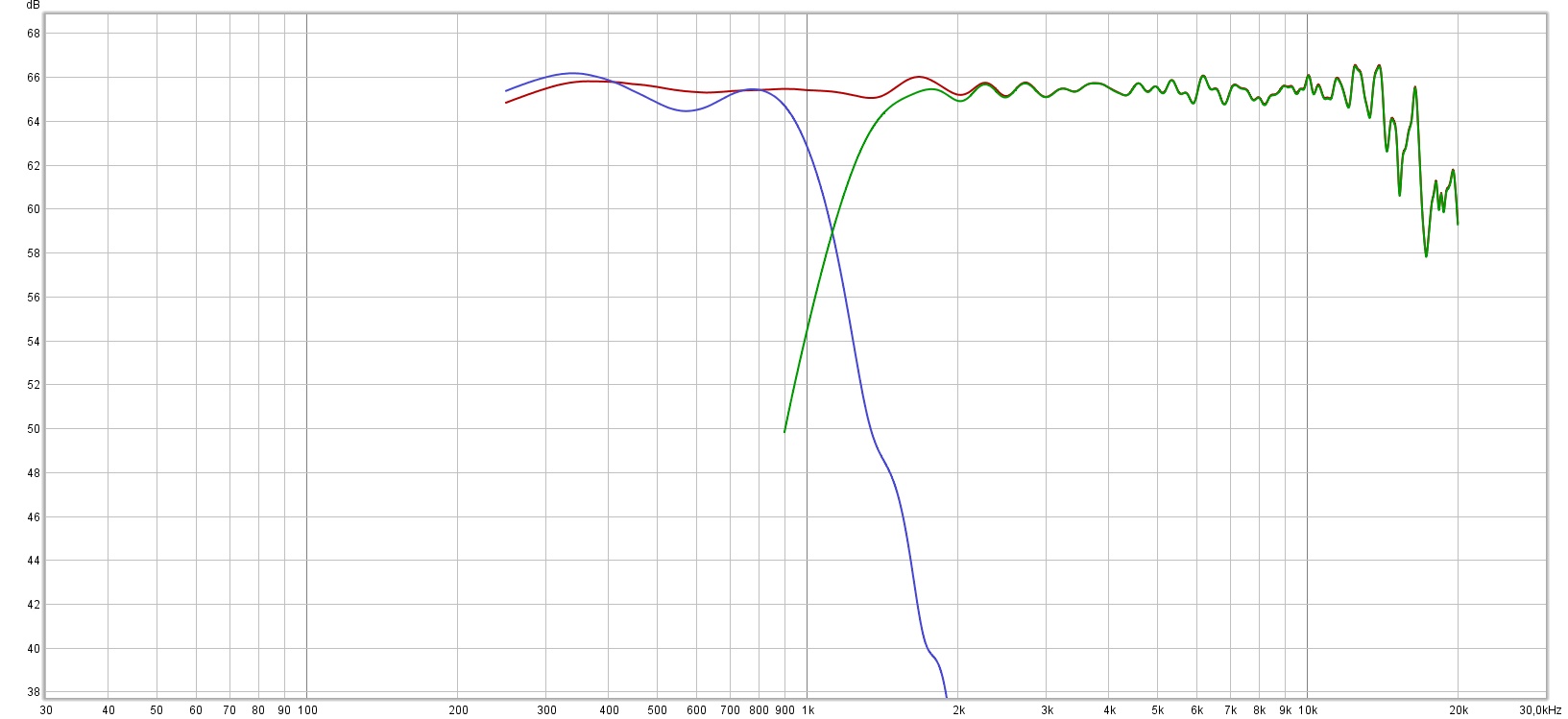
Crossed @1,1kHz with LR 36db filter. This filter was the best sounding and also the best in the measurements. The compression driver is delayed due to the bigger distance to the mic. It was done by trial & error. With a delay of 0,6ms and an inverted midbass I got the biggest dip at the xover frequency. Not a single band of the EQ is left for the CD. But the final FR is pretty flat.
It was measured 1m from the baffle with an calibrated mic on the level of the CD (ear height). Because of the low height I get the reflexions from the ground prette early. I placed an absorber in front of the speaker. You can see the impulse with the window set here:
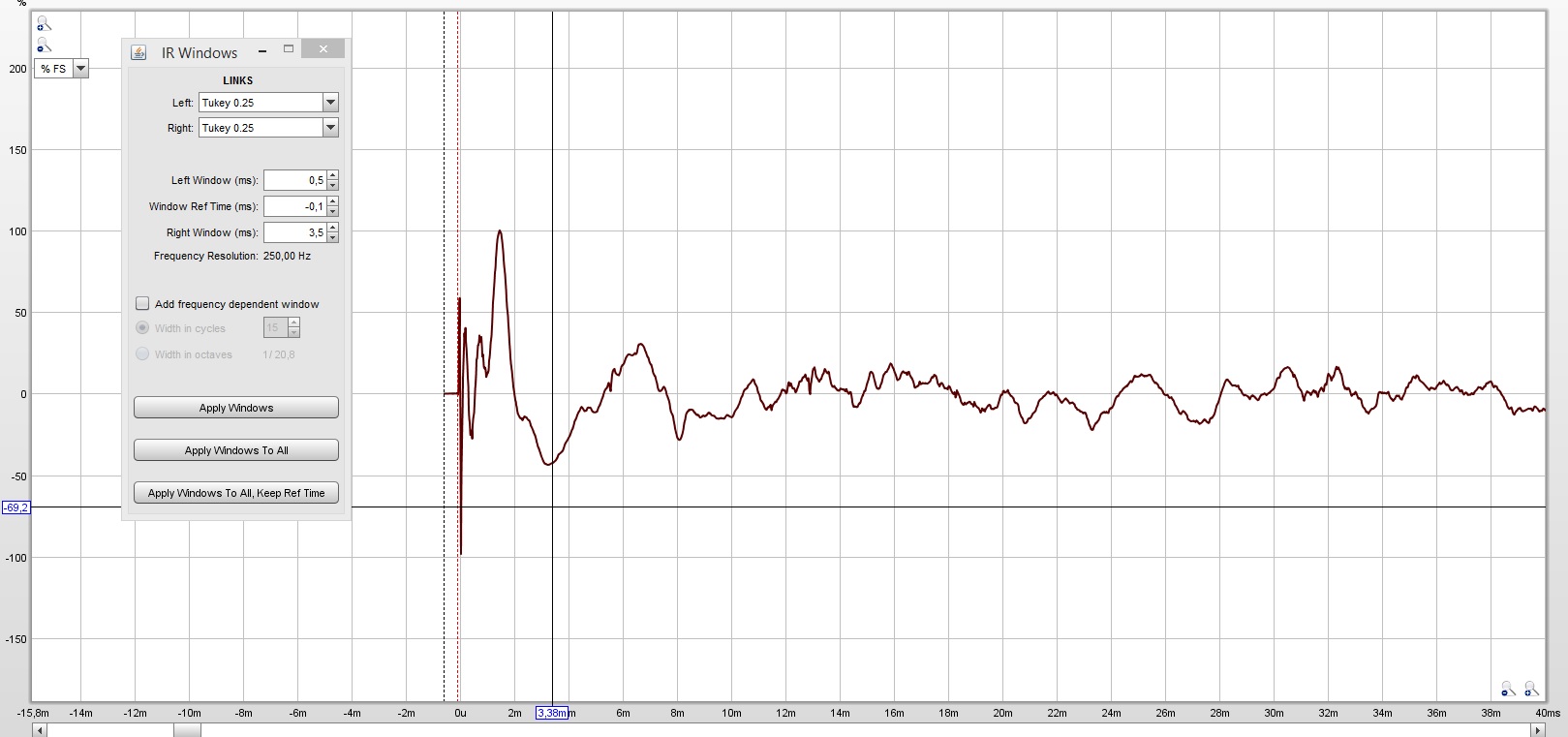
The off axis response looks like this:
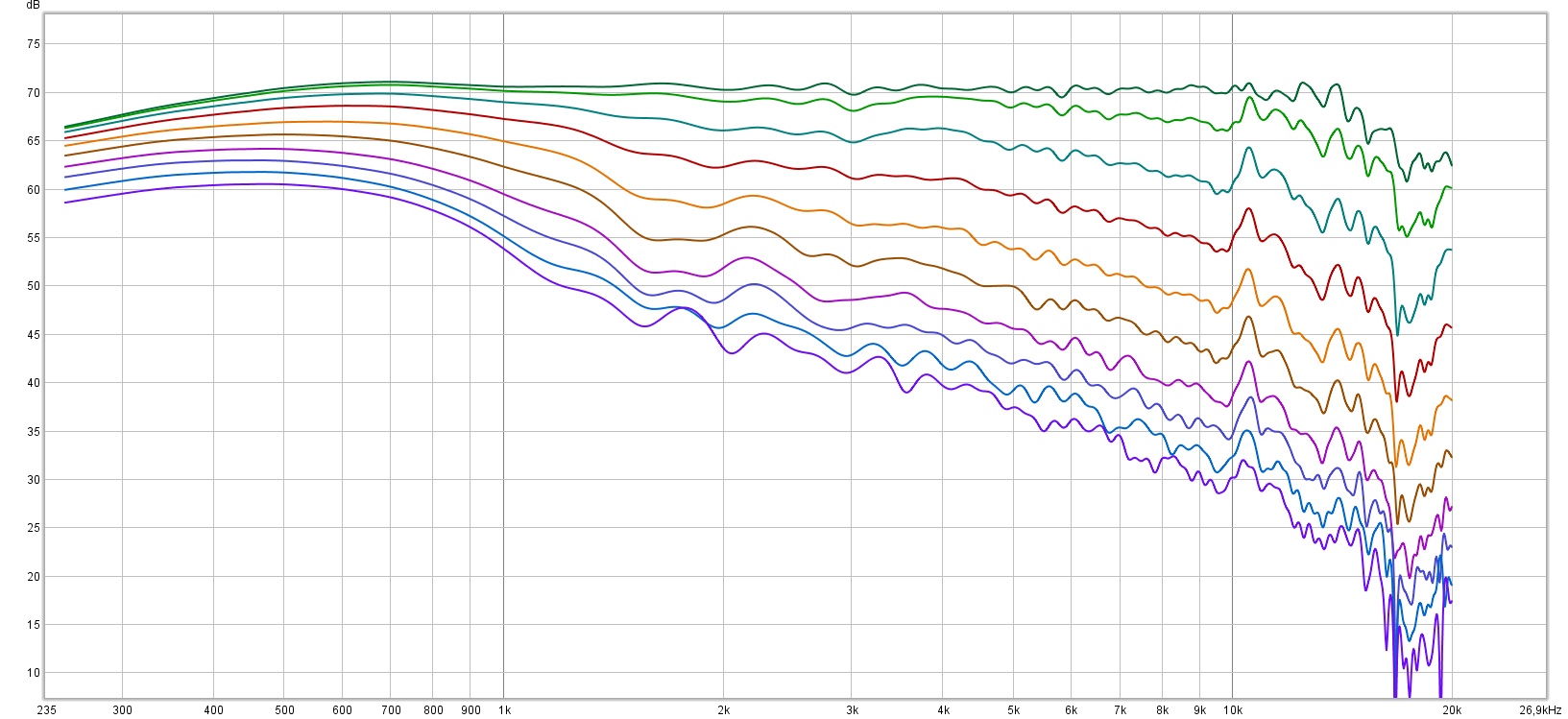
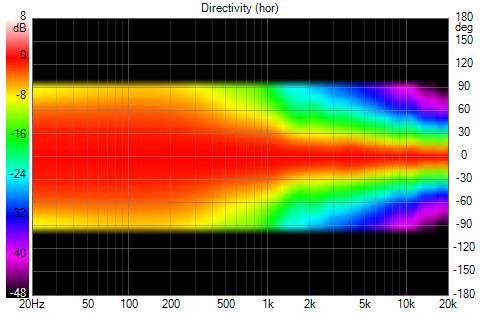
The narrow dispersion of the horn works well with corner placement imo.
Low frequency integration was a bit tricky. With 1m distance to the mic the measurements go down to about 350Hz. Nearfield measurements are only valid up to 200Hz. But the nearfield measurement (and also the simulation) shows that FR of the 12PE32 is not flat at all:
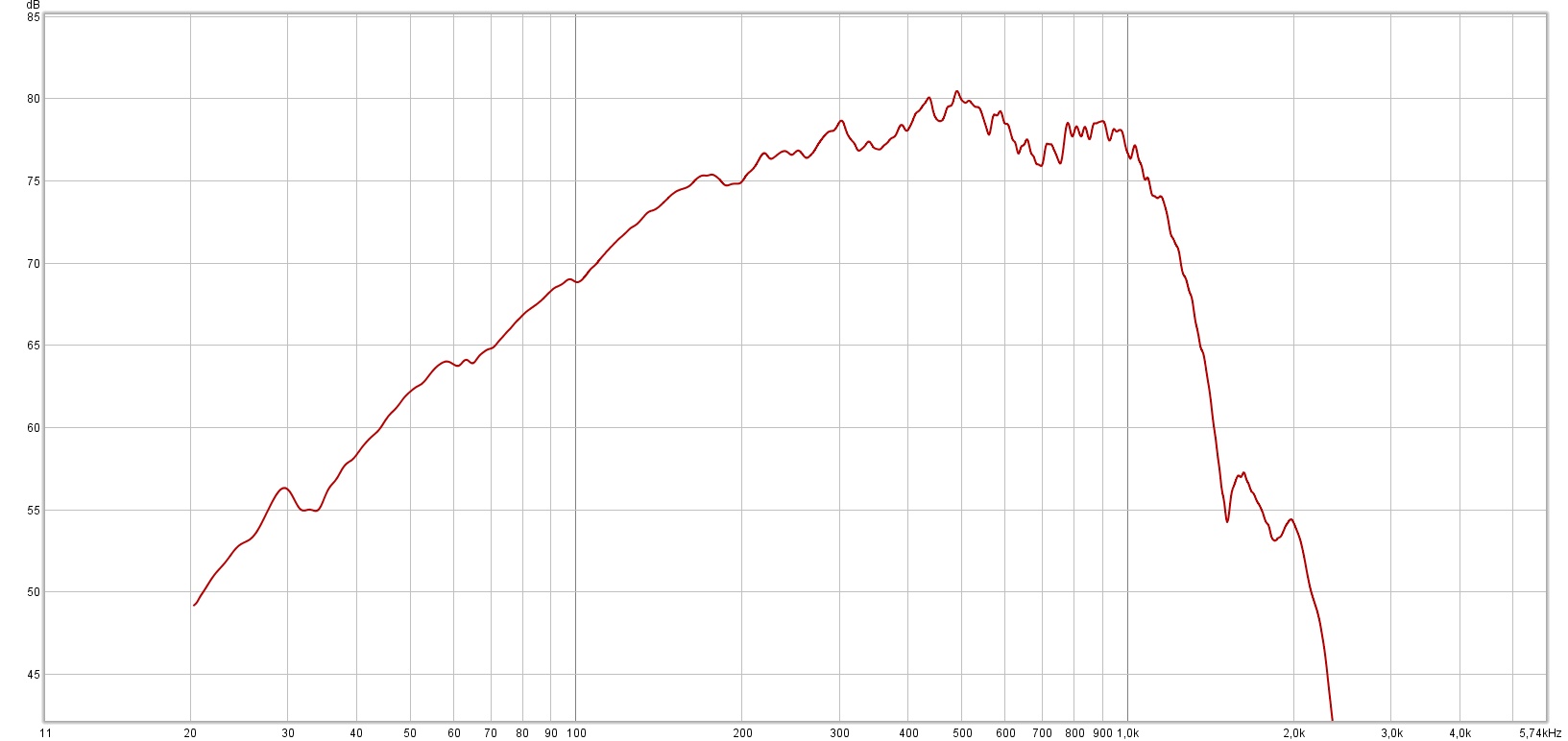
Below 200Hz it’s loosing energy. First I crossed the subs at 80Hz with LR filters. But the measurements on the listening position with mic at 90° showed that the range of ~80-200Hz is lacking. This was audible too. I could try to push the low frequencies on the midbass. But since the xmax is limited (2,8mm) I decided to cross the subs higher.
The front subs are connected to same channel of the DSP & amp. And the back subs are connected to one channel as well. This is because I only have three stereo amps at the moment. So I can’t EQ and delay every single sub seperately. Here is a sketch of the room before I show you the measurements at the listening position.
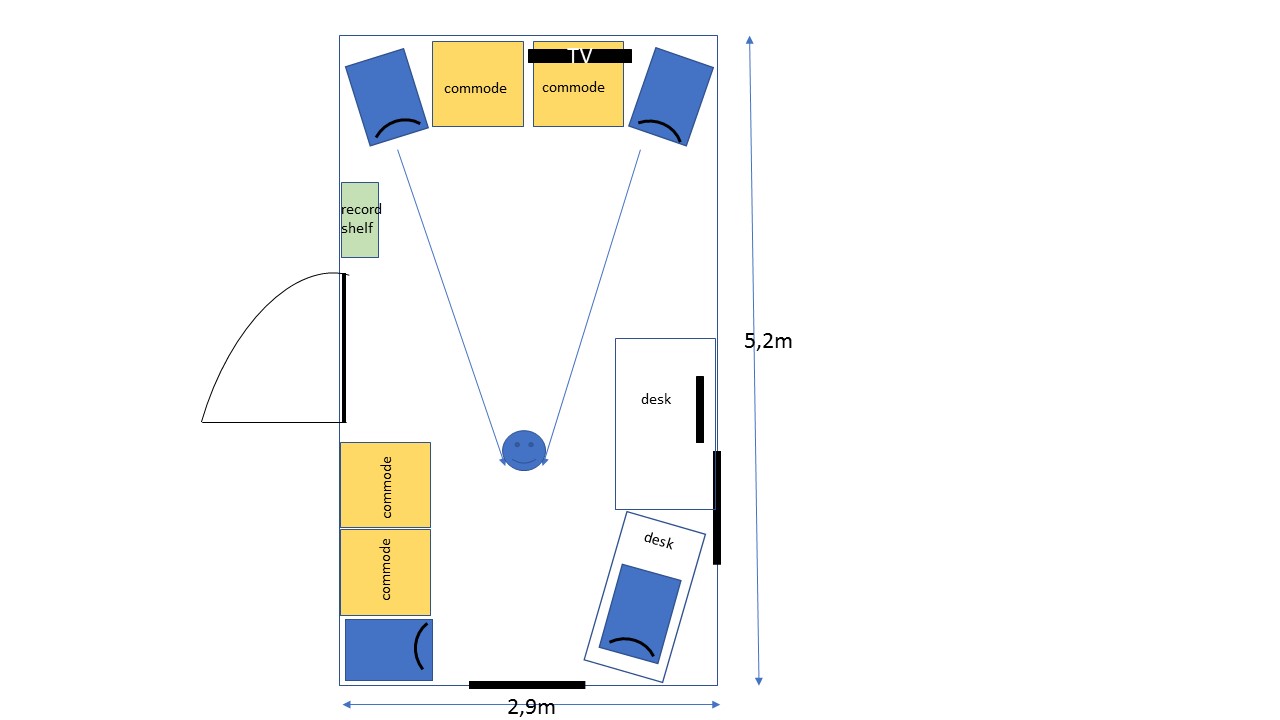
The main speakers are placed on top of the front subs in the corner. I marked my listening position. The sub in the right back corner stands under a desk. I pulled it out of the corner a bit due to the legs of the desk. And I think this is one reason why got this response at the listening position:

The mains got a hp at 120Hz with Bessel 12dB. The front subs are crossed at 120Hz with Bessel 18dB. The back subs are crossed at 100Hz with Bessel 18dB and delayed a little bit. This was done by trial & error. With this filter setup I get pretty flat response from 20-200Hz. What I mean is that the sub frequencies and the kick bass are on the same level. Of course on every other position in the room the bass gets worse because of the eq settings and modes.
What was surprising to me is that I got this kind of bass response near the center of the room. In my first tests with every sub in the corner (especially the one in the right back corner) the bass was best sounding in the back of the room. Towards the center it got worse. But with pulling one sub out of the corner a bit the situation switched.
Here are some more measurements. The red curve is withouth EQ.
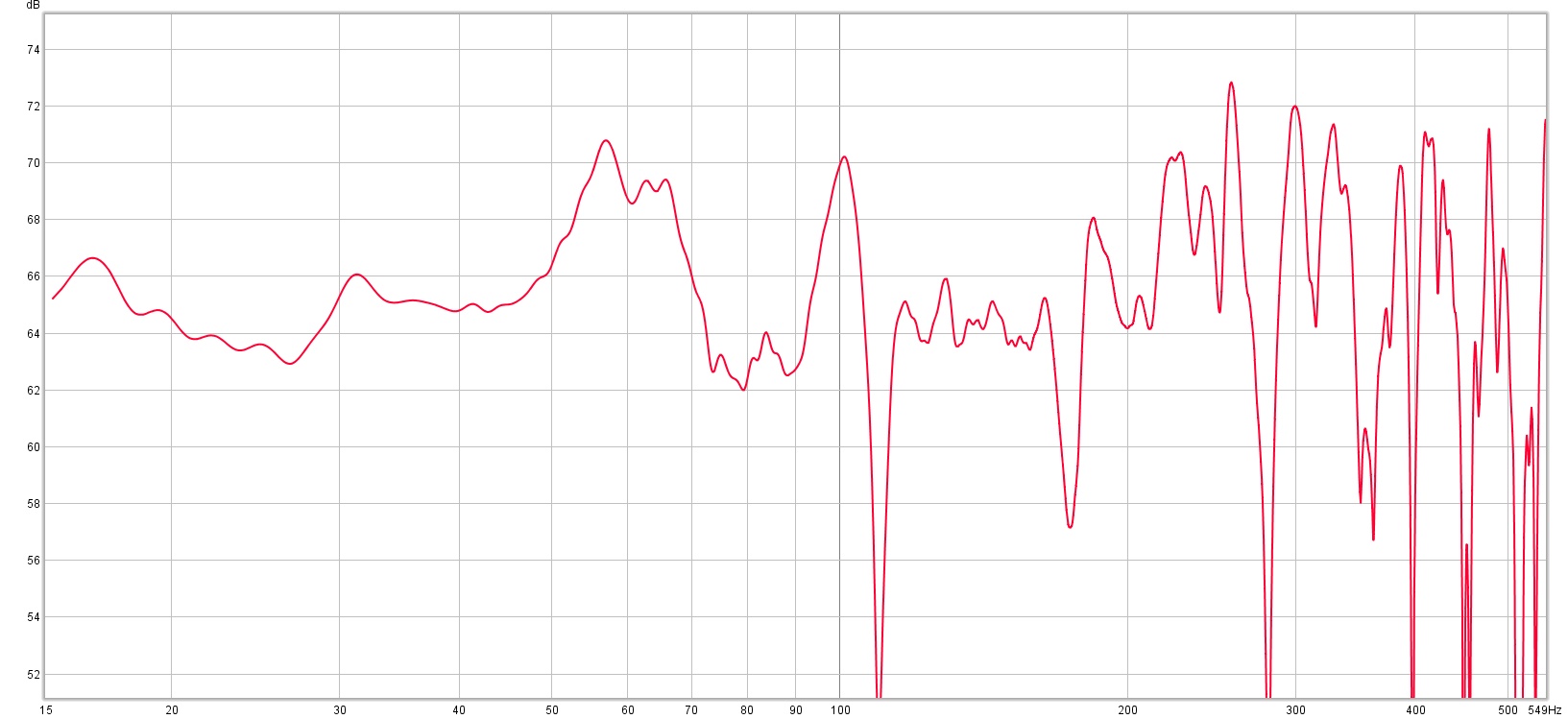
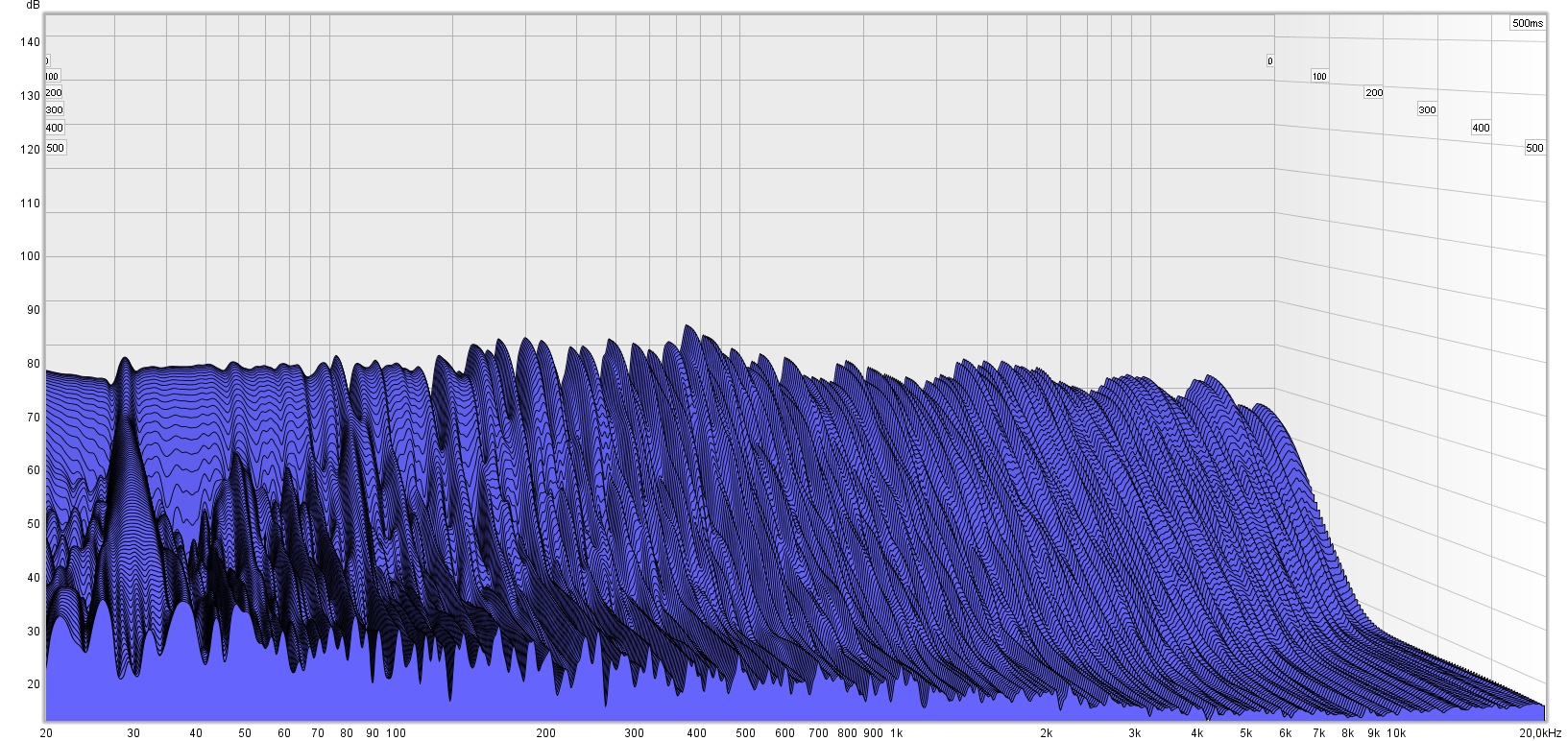
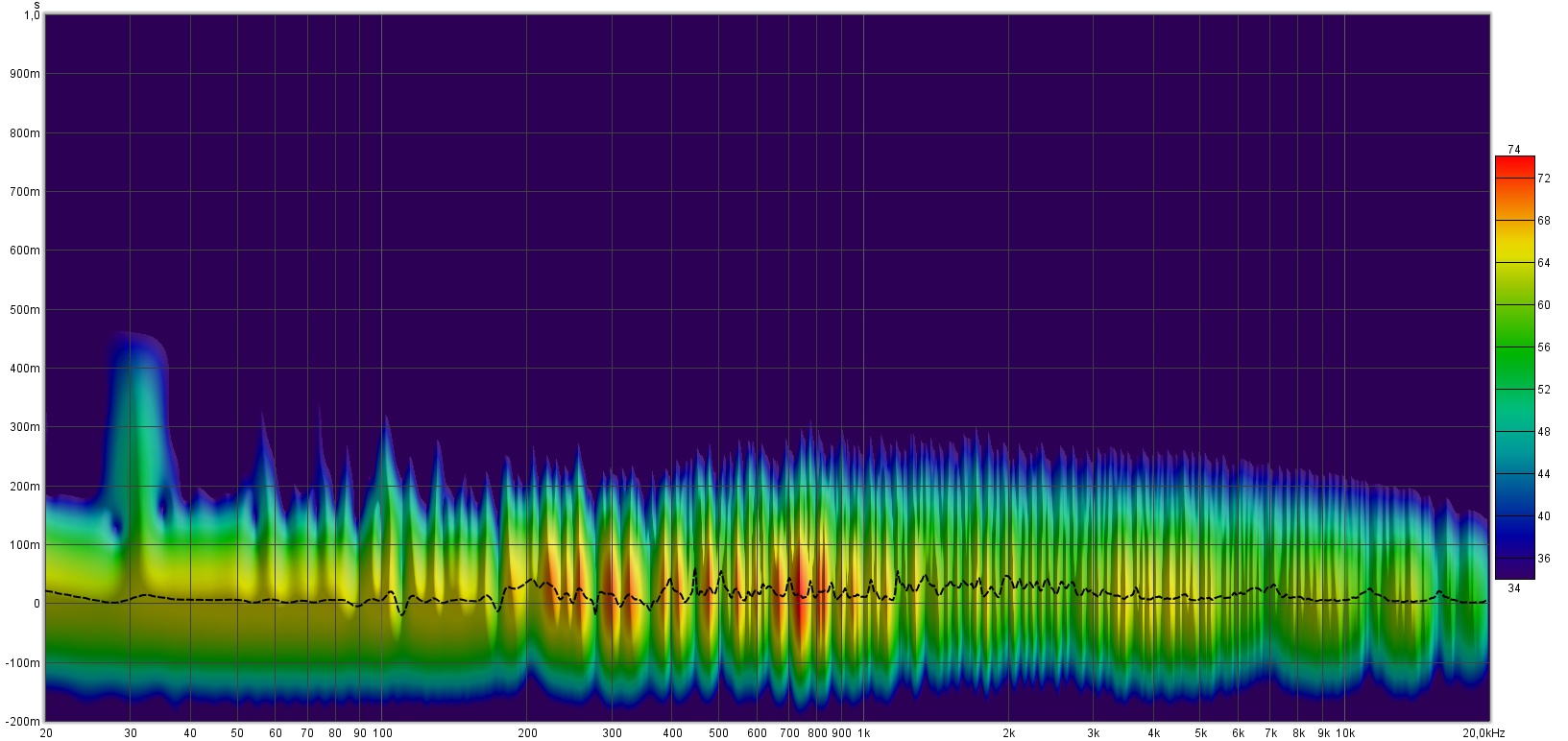
Things I didn’t measure or focus so far:
-Impedance
-Group delay
-Phase settings in the DSP (I just used delays to compensate physical distance)
What do you think about my project? Is the subwoofer integration done well? Or is it worth to try Geddes approach with different placement?
I recently finished my very first project that I want to share with you. Maybe you find some things I can improve. Parts I used:
-Faital Pro HF10AK in 12“ tractrix
-B&C 12PE32 in ~20L cb
-4x Beyma 12BR70 as subwoofers in ~70L (2x) and 80L (2x) cb
-DSP with 8 channels
Unfortunately I don’t have proper pics on my computer. But maybe you get the idea from my profile picture. Every driver has its own box. The speakers are placed in the corners of the room. You can find a sketch down below.
This is how the final measurements looks like:
Crossed @1,1kHz with LR 36db filter. This filter was the best sounding and also the best in the measurements. The compression driver is delayed due to the bigger distance to the mic. It was done by trial & error. With a delay of 0,6ms and an inverted midbass I got the biggest dip at the xover frequency. Not a single band of the EQ is left for the CD. But the final FR is pretty flat.
It was measured 1m from the baffle with an calibrated mic on the level of the CD (ear height). Because of the low height I get the reflexions from the ground prette early. I placed an absorber in front of the speaker. You can see the impulse with the window set here:
The off axis response looks like this:
The narrow dispersion of the horn works well with corner placement imo.
Low frequency integration was a bit tricky. With 1m distance to the mic the measurements go down to about 350Hz. Nearfield measurements are only valid up to 200Hz. But the nearfield measurement (and also the simulation) shows that FR of the 12PE32 is not flat at all:
Below 200Hz it’s loosing energy. First I crossed the subs at 80Hz with LR filters. But the measurements on the listening position with mic at 90° showed that the range of ~80-200Hz is lacking. This was audible too. I could try to push the low frequencies on the midbass. But since the xmax is limited (2,8mm) I decided to cross the subs higher.
The front subs are connected to same channel of the DSP & amp. And the back subs are connected to one channel as well. This is because I only have three stereo amps at the moment. So I can’t EQ and delay every single sub seperately. Here is a sketch of the room before I show you the measurements at the listening position.
The main speakers are placed on top of the front subs in the corner. I marked my listening position. The sub in the right back corner stands under a desk. I pulled it out of the corner a bit due to the legs of the desk. And I think this is one reason why got this response at the listening position:
The mains got a hp at 120Hz with Bessel 12dB. The front subs are crossed at 120Hz with Bessel 18dB. The back subs are crossed at 100Hz with Bessel 18dB and delayed a little bit. This was done by trial & error. With this filter setup I get pretty flat response from 20-200Hz. What I mean is that the sub frequencies and the kick bass are on the same level. Of course on every other position in the room the bass gets worse because of the eq settings and modes.
What was surprising to me is that I got this kind of bass response near the center of the room. In my first tests with every sub in the corner (especially the one in the right back corner) the bass was best sounding in the back of the room. Towards the center it got worse. But with pulling one sub out of the corner a bit the situation switched.
Here are some more measurements. The red curve is withouth EQ.
Things I didn’t measure or focus so far:
-Impedance
-Group delay
-Phase settings in the DSP (I just used delays to compensate physical distance)
What do you think about my project? Is the subwoofer integration done well? Or is it worth to try Geddes approach with different placement?
Attachments
-
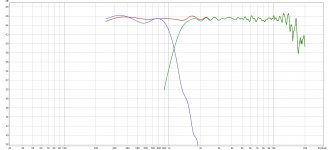 Left Speaker.jpg161.8 KB · Views: 1,272
Left Speaker.jpg161.8 KB · Views: 1,272 -
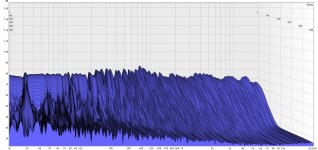 Waterfall.jpg477.5 KB · Views: 1,051
Waterfall.jpg477.5 KB · Views: 1,051 -
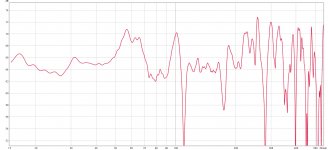 Sub wEG.jpg174.3 KB · Views: 1,072
Sub wEG.jpg174.3 KB · Views: 1,072 -
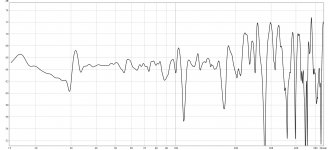 Sub EQ.jpg161.3 KB · Views: 1,072
Sub EQ.jpg161.3 KB · Views: 1,072 -
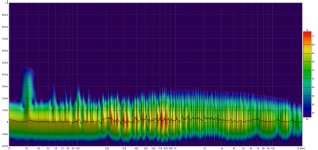 Spectrogram.jpg269.2 KB · Views: 1,024
Spectrogram.jpg269.2 KB · Views: 1,024 -
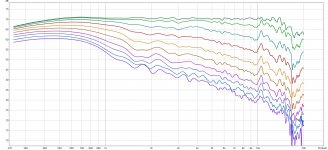 Off axis.jpg281.7 KB · Views: 1,083
Off axis.jpg281.7 KB · Views: 1,083 -
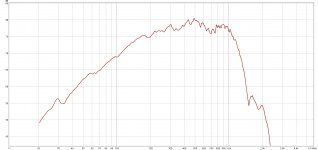 Midbass.jpg133 KB · Views: 1,121
Midbass.jpg133 KB · Views: 1,121 -
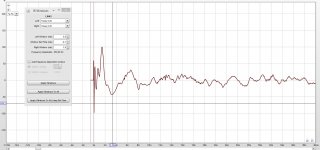 Impulse.jpg174.9 KB · Views: 1,122
Impulse.jpg174.9 KB · Views: 1,122 -
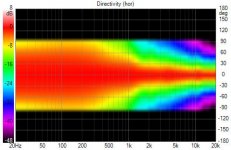 1,1khz polar map.jpg26.4 KB · Views: 1,144
1,1khz polar map.jpg26.4 KB · Views: 1,144 -
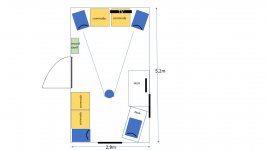 Room.jpg54.5 KB · Views: 1,091
Room.jpg54.5 KB · Views: 1,091
Last edited:
Hi Drumberg.
I rate it 8/10 but perfection doesn't exist so consider 9 as the best possible note from my side and minus 1 because i'm jealous you reached this kind of results in only one year and you started from almost zero about it ( knowledge and all...).
Hats off to you!
You have some things to measure still and sure there could be improvement ( there is always) but well... you did a goodjob.
Multisubs need a bit of trial and errors and iterations to get it right, but you are on a good track imho.
I would try to move back sub to see if you can find 'better' but keep a record of the position you have now.
For E.Geddes approach you would ideally need an eq/delay by sub ( and a third (5th) one too) so it may not be optimal atm.
Now how do you like/rate them? They fulfill your initial needs/will?
Anyway you should be proud of the work done.
I rate it 8/10 but perfection doesn't exist so consider 9 as the best possible note from my side and minus 1 because i'm jealous you reached this kind of results in only one year and you started from almost zero about it ( knowledge and all...).
Hats off to you!
You have some things to measure still and sure there could be improvement ( there is always) but well... you did a goodjob.
Multisubs need a bit of trial and errors and iterations to get it right, but you are on a good track imho.
I would try to move back sub to see if you can find 'better' but keep a record of the position you have now.
For E.Geddes approach you would ideally need an eq/delay by sub ( and a third (5th) one too) so it may not be optimal atm.
Now how do you like/rate them? They fulfill your initial needs/will?
Anyway you should be proud of the work done.
Ok your impuolse response is not the best i've seen. Maybe it is because of trial and errors approach: you may have too much delay on one of the way.
It will be nice to have phase plots to know more.
One question Drumberg: have you taken your measurements at 60db? It seems a bit low in spl to me as room noisefloor must be near( or you live in a very very quiet place but i doubt it).
120 and 180hz notch: room mode or an issue with the front sub xover point ( for 120hz)?
Your horn seems to be well behaved. Do you find the characteristics you were looking for to be present in your system?
It will be nice to have phase plots to know more.
One question Drumberg: have you taken your measurements at 60db? It seems a bit low in spl to me as room noisefloor must be near( or you live in a very very quiet place but i doubt it).
120 and 180hz notch: room mode or an issue with the front sub xover point ( for 120hz)?
Your horn seems to be well behaved. Do you find the characteristics you were looking for to be present in your system?
Last edited:
Hi krivium,
nice to hear from you. I hope you are well 🙂 This wouldn't be possible without your help. I can't thank you and fluid enough
It was a lot of work. Especially the woodworks. But it was a lot of fun and worth every second. I'm very happy with the result. The speakers are what I hoped for but didn't expect. Everything sounds detailed and clear without any harshness. The location of the sounds is great. It's like sitting in one room with the musician. With the current DSP setup it sounds neutral to me. And the horn was the perfect choice because a wider dispersion might be problematic in my room and in the corners. The sweet spot might not be big but my room is just 2,9m wide and you would like to sit right in the middle anyway. When you listen off axis it still sounds natural to me. Maybe it's because of the small room but I don't miss high frequencies off axis. The bass sounds well balanced too. At least I never heard anything better in this room. All in all I couldn't ask for more with this circumstances. But as soon as I started enjoying music it was clear that room acoustics is next on my list 😀
Yes, the measurements were not super loud but I made them mainly in the evening/night and with lockdown it was indeed very quiet. The volume of my measurements might vary because I made a lot of them on different daytimes. But I will try to do louder in the future.
I was thinking about sbir when it comes to the notch at 110 and 170Hz. With corner location sbir should go higher in frequency. But could be a room mode too. I don't think it's because of the xover. The dips were present with different xover points and even without subs if I remember correctly.
My impulse never looked like the ones I saw on the internet. The distance of the CD is bigger and with a delay of 0,62ms I got the best result in FR but from calculating the distances the delay should be shorter. The start of that impulse must be the CD. Right after that the midbass follows (bigger peak). I found some older measurements with different delays. With LR 12dB it looks better I guess? But the FR and sound was worse. Phase is something I lack knowledge...
Is the fourth and fifth attachment what you meant with phase plots?
nice to hear from you. I hope you are well 🙂 This wouldn't be possible without your help. I can't thank you and fluid enough

It was a lot of work. Especially the woodworks. But it was a lot of fun and worth every second. I'm very happy with the result. The speakers are what I hoped for but didn't expect. Everything sounds detailed and clear without any harshness. The location of the sounds is great. It's like sitting in one room with the musician. With the current DSP setup it sounds neutral to me. And the horn was the perfect choice because a wider dispersion might be problematic in my room and in the corners. The sweet spot might not be big but my room is just 2,9m wide and you would like to sit right in the middle anyway. When you listen off axis it still sounds natural to me. Maybe it's because of the small room but I don't miss high frequencies off axis. The bass sounds well balanced too. At least I never heard anything better in this room. All in all I couldn't ask for more with this circumstances. But as soon as I started enjoying music it was clear that room acoustics is next on my list 😀
Yes, the measurements were not super loud but I made them mainly in the evening/night and with lockdown it was indeed very quiet. The volume of my measurements might vary because I made a lot of them on different daytimes. But I will try to do louder in the future.
I was thinking about sbir when it comes to the notch at 110 and 170Hz. With corner location sbir should go higher in frequency. But could be a room mode too. I don't think it's because of the xover. The dips were present with different xover points and even without subs if I remember correctly.
My impulse never looked like the ones I saw on the internet. The distance of the CD is bigger and with a delay of 0,62ms I got the best result in FR but from calculating the distances the delay should be shorter. The start of that impulse must be the CD. Right after that the midbass follows (bigger peak). I found some older measurements with different delays. With LR 12dB it looks better I guess? But the FR and sound was worse. Phase is something I lack knowledge...
Is the fourth and fifth attachment what you meant with phase plots?
Attachments
Subs.. the Geddes method involves moving them around to find a useful place, initially by trial and error. When you have difficult resonances it's worth trying within your accepted limits of movement. In other words even if you keep the corner positions and just make slight adjustments.
Integrating the 12PE32 with a subwoofer is going to be near impossible. It's a very low QTS driver with a very aggressive rising response. This driver is more commonly used in horn loading which sums to a flat response from 100Hz-600Hz in that configuration.
Below is the published frequency response on the 12PE32. I suggest you look for a 12" midbass with a higher QTS.
Below is the published frequency response on the 12PE32. I suggest you look for a 12" midbass with a higher QTS.
Attachments
Drumberg, nice system!
In the first post you say "the compression driver is delayed" - but you have to delay the other drivers, in order to reach time alignement!
Did you try EQing the low end response of the 12PE32? The mid bass response looks very ragged to me. Maybe play a bit with improvised absorbers, some cushions or whatever you have laying around?
Do you have any stuffing in the 12PE32 box?
I second the notion to measure at a higher volume. Personally i would also look at the 12PE32 response with a close mic setup, then try to get it clean at the LP before integrating it with the sub.
But good work! If you only got into speaker building a year ago that is really an impressive achievement already!
In the first post you say "the compression driver is delayed" - but you have to delay the other drivers, in order to reach time alignement!
Did you try EQing the low end response of the 12PE32? The mid bass response looks very ragged to me. Maybe play a bit with improvised absorbers, some cushions or whatever you have laying around?
Do you have any stuffing in the 12PE32 box?
I second the notion to measure at a higher volume. Personally i would also look at the 12PE32 response with a close mic setup, then try to get it clean at the LP before integrating it with the sub.
But good work! If you only got into speaker building a year ago that is really an impressive achievement already!
I'm sorry, of course the midbass has a 0,62ms delay. I just checked the DSP settings. When making the xover I was paying attention to that. Unfortunately I'm not sure if the CD is delayed on the impulse diagrams I postet after that. I made a lot of measurements and didn't lable them good enough. I will try to make new measurements leaving the speakers in the corner. I expect them to be not accurate enough but maybe I works for the first ms of the impulse and the xover range.
The 12PE32 is indeed perfect for horns and that was the initial reason why I bought it. The dream was to build a midbass horn later as an upgrade. And I didn't want to buy a second pair of drivers. But this won't happen in the near future (I hope 😀 ). Today I would probably go for the Faital 12PR320 as I'm impressed by the HF10AK.
To get the FR flat in cb I used a shelf filter. Other than that there is not much eqing going on. Just small corrections on some specific frequencies like -2dB @100Hz.
For stuffing I used insulation material made from wood fibers. You can compare it to the mineral/glass wool with low density which is also used for bass traps. I used it to increase the volume seen by the subs and also used it in the midbass because I had it. My impression is that it absorbs the sound well. But I didn't make specific tests.
I posted the waterfall diagramm so you can evaluate the integeration of the subs better. But I guess a measurement without EQ on the subs would be better the see the room modes. Because I don't know if the modal activities in my room can be improved by Geddes style approach. Now I'm more on the Welti side cutting the midbass on the low a bit. Even without subs I noticed massive room gain below ~60Hz. The front subs are fixed on the position. But with the other two I'm ready to experiment. I just need another amp to eq and delay them properly. But I would only start with all this if there is hope to get a better response or less modes.
Another thing I want to add is absorbers. I thought about 20cm material + 20cm distance to the wall on the whole wall behind the speakers. And a pair for early reflections. At the moment I have one 12cm absorber in one corner made from left over material.
The 12PE32 is indeed perfect for horns and that was the initial reason why I bought it. The dream was to build a midbass horn later as an upgrade. And I didn't want to buy a second pair of drivers. But this won't happen in the near future (I hope 😀 ). Today I would probably go for the Faital 12PR320 as I'm impressed by the HF10AK.
To get the FR flat in cb I used a shelf filter. Other than that there is not much eqing going on. Just small corrections on some specific frequencies like -2dB @100Hz.
For stuffing I used insulation material made from wood fibers. You can compare it to the mineral/glass wool with low density which is also used for bass traps. I used it to increase the volume seen by the subs and also used it in the midbass because I had it. My impression is that it absorbs the sound well. But I didn't make specific tests.
I posted the waterfall diagramm so you can evaluate the integeration of the subs better. But I guess a measurement without EQ on the subs would be better the see the room modes. Because I don't know if the modal activities in my room can be improved by Geddes style approach. Now I'm more on the Welti side cutting the midbass on the low a bit. Even without subs I noticed massive room gain below ~60Hz. The front subs are fixed on the position. But with the other two I'm ready to experiment. I just need another amp to eq and delay them properly. But I would only start with all this if there is hope to get a better response or less modes.
Another thing I want to add is absorbers. I thought about 20cm material + 20cm distance to the wall on the whole wall behind the speakers. And a pair for early reflections. At the moment I have one 12cm absorber in one corner made from left over material.
I started measuring again. You were right. The Impulse is not correct. There are phase problems at the xover created by the filter. And in my first attempt I corrected it with delay. This gave me a better FR but wasn't right. I'm experimenting with allpass filter to correct the phase issues but the FR doesn't get perfect. With LR24dB I get a good result with good summation of both ways. But with LR36dB it wasn't possible. I need a inverse allpass afaik and that would be FIR.
Luckily my DSP has FIR. I will experiment with it to see what I can achieve with. Then I will try to get close with normal filters. Did you see similar projects or similar horns before in this forum? In general what would be a typical filter type for this?
Luckily my DSP has FIR. I will experiment with it to see what I can achieve with. Then I will try to get close with normal filters. Did you see similar projects or similar horns before in this forum? In general what would be a typical filter type for this?
Note that some things can be attended to with FIR while others shouldn't. If you apply FIR because 'things don't add up' then the result will remain uncertain.
Yeah I know that FIR isn't the solution for everything. But I have the opportunity so I will try it. To get the best result I need to try anyway. Otherwise there will always be that "what if...."
Atm it's hard to choose which delay for the midbass is right. On the impulse 0,3ms looks best to me. But the FR looks better with 0,15ms. But this is also due to the corner placement. The measurement below 1kHz looks different from my measurements in the middle of the room. So will make measering session in the next days.
Atm it's hard to choose which delay for the midbass is right. On the impulse 0,3ms looks best to me. But the FR looks better with 0,15ms. But this is also due to the corner placement. The measurement below 1kHz looks different from my measurements in the middle of the room. So will make measering session in the next days.
Recently Mark 100 had a thread about wavelets and their use... worth a search about it imho!
In case you are lazy here is the article he referenced: Signal Aligning Using Wavelets
About measurements could it be possible to perform a session outside Drumberg?
It could help you identify which artifacts come from the room.
In case you are lazy here is the article he referenced: Signal Aligning Using Wavelets
About measurements could it be possible to perform a session outside Drumberg?
It could help you identify which artifacts come from the room.
Last edited:
I know it seems like I link to this paper every chance I get.
A Bessel Filter Crossover, and Its Relation to Others
But to get the best results using Bessel it is a must IMO.
For those that need the important bits (ez-mode cheat-sheet) it's under the heading:
Rane's Bessel Crossover at -3 dB
In that document.
A Bessel Filter Crossover, and Its Relation to Others
But to get the best results using Bessel it is a must IMO.
For those that need the important bits (ez-mode cheat-sheet) it's under the heading:
Rane's Bessel Crossover at -3 dB
In that document.
Another method in case wavelets doesn't inspire you:
Finding the Relative Acoustic Offset in PCD.pdf - Box
Same principle: Time-Alignment
Kaffiman, yes worth a try imho. The thing which is interesting with closed box and dsp is it open to many variations to be implemented and choose the one you prefer.
Bessel 2 pole could be implemented using a Linkwitz transform on 12pe12 for Q 0.577 at 94hz hp and a dsp bessel lp 2p at 152hz on front beyma for example.
Drumberg as you'll need some low latency filters ( real time monitoring) i suggest you to find a IIR answer which you find suitable.
But i would first try to find the best compromise about sub xover freq ( taking driver CTC, SBIR, room schroeder freq, overall rendering into account), then time align at choosen freq and then target differents solution and compare results ( and if you want eq bandpass +/-1 octave do it before time align).
You could try an LT on your subs too, targeting different value of Q from 0,9 (70l should be close to 0,9) to 0,577 and see which one integrate best with your room.
Fir may or may not help. This is only an answer among others and as trying differents options will only cost time and patience... it as to be tried ( but latency 'au menu').
Finding the Relative Acoustic Offset in PCD.pdf - Box
Same principle: Time-Alignment
Kaffiman, yes worth a try imho. The thing which is interesting with closed box and dsp is it open to many variations to be implemented and choose the one you prefer.
Bessel 2 pole could be implemented using a Linkwitz transform on 12pe12 for Q 0.577 at 94hz hp and a dsp bessel lp 2p at 152hz on front beyma for example.
Drumberg as you'll need some low latency filters ( real time monitoring) i suggest you to find a IIR answer which you find suitable.
But i would first try to find the best compromise about sub xover freq ( taking driver CTC, SBIR, room schroeder freq, overall rendering into account), then time align at choosen freq and then target differents solution and compare results ( and if you want eq bandpass +/-1 octave do it before time align).
You could try an LT on your subs too, targeting different value of Q from 0,9 (70l should be close to 0,9) to 0,577 and see which one integrate best with your room.
Fir may or may not help. This is only an answer among others and as trying differents options will only cost time and patience... it as to be tried ( but latency 'au menu').
Last edited:
Thanks krivium and KaffiMann. I will read the documents.
Measuring outside is not that easy. The speakers are heavy af + amps + I'm using pc no notebook. I tested using an absorber in front of the speakers. There was a little difference after about 2-3ms I guess. But the initial impulse won't be without artefacts because of the filters used afaik.
I made different presets with all filter types and slopes with good result imo. Just by listening I can't judge which one is the best. The FR is slightly different so I don't know if difference comes just from the filter or overall FR. My impression is that the feeling of the room and location of musicians and instruments changes a bit. My favourite is Butterworth and Bessel 24db @1,1kHz so far. 12dB slopes @1,3kHz sound okay but I prefer 24db. With LR filters I got 24db to work and one with different slopes 24 and 36dB.
My problem atm is that I can't judge from the measurements which one is the best. They are close. Choosing what I like more would be easy but I want something neutral so I need to know which one is "right". But maybe the article about wavelets will help me. At least my delay settings are much better now. Showing all the different measurements would be too much I guess. But down below you can see my favourite two Butterworth and Bessel 24dB.
I will EQ my drivers from scratch. Now it's just about the crossover filters. Give me some time and I'll come up with my solution.
Measuring outside is not that easy. The speakers are heavy af + amps + I'm using pc no notebook. I tested using an absorber in front of the speakers. There was a little difference after about 2-3ms I guess. But the initial impulse won't be without artefacts because of the filters used afaik.
I made different presets with all filter types and slopes with good result imo. Just by listening I can't judge which one is the best. The FR is slightly different so I don't know if difference comes just from the filter or overall FR. My impression is that the feeling of the room and location of musicians and instruments changes a bit. My favourite is Butterworth and Bessel 24db @1,1kHz so far. 12dB slopes @1,3kHz sound okay but I prefer 24db. With LR filters I got 24db to work and one with different slopes 24 and 36dB.
My problem atm is that I can't judge from the measurements which one is the best. They are close. Choosing what I like more would be easy but I want something neutral so I need to know which one is "right". But maybe the article about wavelets will help me. At least my delay settings are much better now. Showing all the different measurements would be too much I guess. But down below you can see my favourite two Butterworth and Bessel 24dB.
I will EQ my drivers from scratch. Now it's just about the crossover filters. Give me some time and I'll come up with my solution.
Attachments
I made some measurements in the middle of the room again. It took so long that I focused mainly on the EQ settings to get both drivers flat. I think the effects of the crossover filters should be visible with corner placement if I know how the drivers behave in the middle of the room. The midbass is playing flat until about 3kHz and the compression driver goes flat down to 600-650Hz. There is a 1db offset in the measurement so you can see it better. Measurements were done at 85-90dB but I didn't use the gain knob on my interface input much. Most of the time there is no smoothing on the curves.
I tried some different filter types and Bessel 24dB gave me the best results in the FR. To get these results I used an allpass filter at 850Hz on the midbass. Otherwise there was a dip in that area and the group delay showed the same at 850Hz. The midbass was delayed 0,4ms. With lower delay times there was a light dip in the xover range just like it is written in the rane paper about Bessel crossovers. The xover was 1,1kHz but from looking at the graphs it looks like it is 1,3kHz. Maybe that's because the cd loses energy below 600Hz but the midbass goes well up to 3kHz. The off-axis response got worse compared to my start with LR 36dB. But for me it doesn't look like a big problem, right? I guess the promblems at 1,6-2kHz come from the midbass because at this frequency there is already narrow dispersion.
Tbh I didn't understand that Bessel paper 100% or to be more precise the "Crossover at -3dB" part. The overlap with Besser filters is already big. Now they use a lowpass at 1272Hz and a highpass at 786Hz for a second order crossover at 1000Hz. The overlap is getting very big with this setup. In my case I can't cross the cd that low. In the FR is already pretty flat (even I don't know if the phase and time alignement is correct).
The methods from J. Bagby and T. Gravesen and the wavelets are interesting methods that I could test. But it was much information in the last days and I will keep that for the future until I feel the urge to improve the system again. Now I want to make some music and get some listening experience. I think it's better for me to read more about crossover design before trying different stuff. Only thing I will check now is subwoofer xover and delay. There was a big improvement by changing the mains filter. I think the relation between subs und midbass changed and it sounded more punchy.
I tried some different filter types and Bessel 24dB gave me the best results in the FR. To get these results I used an allpass filter at 850Hz on the midbass. Otherwise there was a dip in that area and the group delay showed the same at 850Hz. The midbass was delayed 0,4ms. With lower delay times there was a light dip in the xover range just like it is written in the rane paper about Bessel crossovers. The xover was 1,1kHz but from looking at the graphs it looks like it is 1,3kHz. Maybe that's because the cd loses energy below 600Hz but the midbass goes well up to 3kHz. The off-axis response got worse compared to my start with LR 36dB. But for me it doesn't look like a big problem, right? I guess the promblems at 1,6-2kHz come from the midbass because at this frequency there is already narrow dispersion.
Tbh I didn't understand that Bessel paper 100% or to be more precise the "Crossover at -3dB" part. The overlap with Besser filters is already big. Now they use a lowpass at 1272Hz and a highpass at 786Hz for a second order crossover at 1000Hz. The overlap is getting very big with this setup. In my case I can't cross the cd that low. In the FR is already pretty flat (even I don't know if the phase and time alignement is correct).
The methods from J. Bagby and T. Gravesen and the wavelets are interesting methods that I could test. But it was much information in the last days and I will keep that for the future until I feel the urge to improve the system again. Now I want to make some music and get some listening experience. I think it's better for me to read more about crossover design before trying different stuff. Only thing I will check now is subwoofer xover and delay. There was a big improvement by changing the mains filter. I think the relation between subs und midbass changed and it sounded more punchy.
Attachments
FWIW I also had some luck with elliptic filters as long as it's over 1khz or so. A 3rd ir 4th order elliptical filter might be fun to try.
There were different filter types mentioned here. But I can choose from "standard" Bessel, Butterworth and LR with different slopes. I don't even know how to implement an elliptic filter. With my DSP it's possible to change things in Sigmastudio but I didn't get into that. And I'm not going to try FIR because I only have four channels because of limited taps and it needs more software work.
For now I'm happy with the setup. My next upgrade is a new interface. I can connect the new interface to my dsp with SPDIF (or ADAT) and save one D/A conversion.
For now I'm happy with the setup. My next upgrade is a new interface. I can connect the new interface to my dsp with SPDIF (or ADAT) and save one D/A conversion.
Drumberg, try an LR 12 as well. They will sum flat if the horn polarity is set to rev in the filter, but you must have the the group del set. Try some rock music and flip between LR 12 and 24. I have had some hardening effect on my setup at 24 LR.
Power response comparison with Linkwitz-Riley crossovers
Power response comparison with Linkwitz-Riley crossovers
Last edited:
Drumberg ... that paper outlines the optimally flat response for the Bessel filter but you're in error as far as it's implementation. It's not an overlap but a spread. The CD would have the 1272hz setting and the woofer the 786hz setting. (these are approximate as well).
- Home
- Loudspeakers
- Multi-Way
- Rate my 2-way horn speaker + subwoofer
